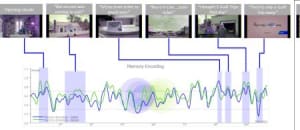
V/Line was one of the big Aussie winners at Cannes this year taking home a Creative Effectiveness Lion – a look at the brain science behind the ads, shows that it's the emotional manipulation behind the sentiment that makes it effective – and that it gets dads more than mums.
As part of our exclusive series of neuro-analyses of the winning ads at Cannes this year in partnership with Neuro Insight, we took a look at how viewers' brains respond to V/Line's Guilt Trips ads.
Victory for V/Line
The guilt strings have been tugged again at Cannes this year with another clever campaign that is amusing, yet emotionally manipulates us at the same time. The V/Line Guilt Trip campaign centred on the notion that often, the only reason we might use V/Line to see family in the country is out of a sense of obligation or guilt. In order to combat this, V/Line created a Guilt Trip voucher that can be sent to loved ones living in the city, reminding them to come home to visit their friends and family. The campaign was extensive, using mainly social media and outdoor exposure, but TV did play a small part. V/Line released a light-hearted ad around a lovely women, Pat, who is telling us how she has mastered the “Art of the Guilt Trip” to get her loved ones to come home and visit her in the country. This ad was awarded a Creative Effectiveness Lion, and rightly so, as the whole campaign increased off-peak sales by 15%. Neuro-Insight analysed the ad to gain a small insight into how the themes and concepts behind the campaign could have had such an impact on sales.
In contrast to what we saw in the Harvey Nichols ad, where women responded most effectively to the ‘guilty pleasures’ message, it is the men who respond most strongly to ‘Guilt Trip’. Looking at the overall average for the ad, men responded with greater emotional intensity, engagement and, most importantly long-term memory encoding. While the overall averages give some indication of the impact of the ad, it is only when we drill down and look at the second-by-second changes in memory encoding that we see the ad’s effectiveness.
The ad starts off well in the male audience with strong Memory Encoding when we see Pat’s sad-but-happy photos which sets the stage well for the rest of the ad. Global Memory (contributing to encoding moods and themes) is very strong when we find out that “no-one was coming to visit” showing that the ad’s “Guilt” theme is being communicated effectively to male viewers. “No-one was coming to visit” was also associated with a ‘withdraw’ or negative Emotional response coupled with high Emotional Intensity (not shown here) indicating that, at this point, male viewers do feel a negative emotion, most likely anxiety and possibly guilt. Key phrases, that I’m sure most of us have heard before are also encoded well, such as “It’s only my 40th, nothing special”, “ahh no, I’m fine” and “I know you won’t bother reading this letter”. These statements have been committed to memory, giving us a glimpse of the campaign’s effectiveness, but more is unveiled towards the end of the ad.

After the 90 second mark, men’s Memory Encoding has strong peaks which all occur around either visual or verbal branding of either V/Line or Guilt Trip. Neuro-Insight’s benchmark for Effectiveness is 0.7 which these branding peaks tower over. The visual of Pat’s “guilty pleasure”, the V/Line Guilt Trip ticket, has a Detail Memory score of 1.14, while final branding of “They’re only a Guilt Trip away” received a Global Memory score of 1.27! Those calibre of scores are only found in our top 99.9th percentile! On a side note for interest’s sake, notice how male viewers had strong Engagement (not shown here) and Memory levels during the final scenes of the man and his son, who “saved the pub” – and also notice how, in the next video, the female audience were unaffected by his ‘heroism’
While the overall or average level of memory encoding was lower in the females, they responded to similar elements of the narrative and the ad still performed well with highly effective branding moments. The important voice-over ‘but no-one was coming to visit’ elicited the same negative emotional state that is consistent with anxiety and possibly guilt in both males and females. Even though the final branding of “Guilt Trip” isn’t as high in the female audience, the earlier branded components such as the ‘Guilt Trip’ ticket and the scene where the father announces that he ‘bought 5 Guilt Trips that day’ are very strongly encoded in memory. Thus, even though the males respond most effectively to the humorous narrative of the ad, the brand and key message are communicated equally effectively in males and females.

Considering how effectively the brand, themes and concepts were communicated in this one piece of collateral, it’s no surprise then that the rest of the Guilt Trip campaign increased sales by 15%! The Guilt Trip ad is definitely very well deserving of the Creative Effectiveness Lion!
We've also looked Volvo's Jean-Claud Van Damme fuelled Epic Split, the Harvey Nichols' 'Sorry I Spent it on Myself' ad, and Lurpak's Creative Effectiveness Lion winning Weave Your Magic ad.
Have something to say on this? Share your views in the comments section below. Or if you have a news story or tip-off, drop us a line at adnews@yaffa.com.au
Sign up to the AdNews newsletter, like us on Facebook or follow us on Twitter for breaking stories and campaigns throughout the day.

